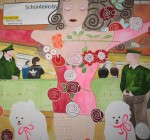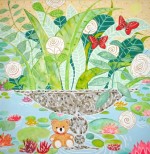Whitehot Magazine
April 2024
"The Best Art In The World"
"The Best Art In The World"
April 2024
August 2008, Interview with Juwelia Soraya

The “Gallery Studio St. St.” is a space devoted to transvestite/erotic art and literature. It is located in the emerging artists' quarter of Neukölln, in Berlin. The gallery holds both exhibitions and performances by a group of transvestite artists: Beverly Schnett, Zsa Zsa Puppengesicht and Juwelia Soraya.
I visited the place on the 24th of June. The gallery is an over decorated room that seems more like a lounge room than a traditional art space. The people could sit anywhere and talk being surrounded by walls that are covered by colorful paintings of different sizes. In the gallery Juwelia Soraya was the one person standing out from the rest of the people because of the way she was dressed. She wore an elegant and also colorful evening dress which seemed to come out from a fairy tale. One could say that she was the exhibition herself, but after taking a look at the paintings, it was clear that they definitely deserved attention. When I decided to interview her, I expected to find a more extroverted person, but in fact she is very delicate and shy. In the interview it’s possible to see how easy it was for her to escape from my questions and put her own world over them simply with her answers. That’s always a noble quality.
DC: Can you speak a little about your work, describing briefly what you are doing, and what you are interested in?
JS: I’ve always liked to paint. When I was a child, I used to paint small naive pictures in dark colors; scenes of dreams and green landscapes that I made and framed with wooden frames. I still do it now, it's just that I -my style- became more colored and that today I paint on bigger canvases in pop-style. I love self portraits that show me as a great diva or as a singer with an orchestra, or huge flower arrangements with roses and furry dogs. I want the world to be a little more colorful, inebriated and decorated with a lot of chi chi chi; that's why I also dress as a woman and enjoy singing romantic love songs, or why I create shows wearing perfumed panties and using pastel colored cards that I then present on the mini-stage in my gallery.
DC: When I see works by transvestite artists, there are a series of materials that appear again and again: pink color (or light colors in general), the idea of happiness, glamour, pop culture, sexual content, etc. Even when these things are present in your work (except maybe explicit sexual content), I feel that they are not present in the same way as they do in the works of most of the transvestite artists I’ve seen. Somehow you managed to escape from the cliché. But how do you relate with these “common places” present in a lot of transgendered artists? And why do you think this kind of motifs appear so often?
JS: I don't orientate myself in regards to other transvestites. My art has nothing to do with this. If I had come to the world as a woman, I would be dressing as a man. I play with the genders and for me it’s exciting to be another sex. I consider the week-end shows as art. I don't need drugs, I am my own drug. The world of homosexuals and transvestites sometimes is a little too stressful for me... too artificial, unpleasant, inflamed and excessive. I prefer to be more lounging, calm, and in a relaxed mood. I also do not conform to the cliché of a transvestite, that is to say, for example, that I could not be used as a transvestite in a movie, but only as an odd woman. It has advantages and inconveniences. Also, I don't take sexuality that seriously. I have been married for 20 years. What does this mean? I am who I am, I don't think about it. It's the same with my art: I make it when I think: “ah it's cool, it looks good, it's something different”. The only thing is that it can not look sad, but in some way happy and luxurious.
DC: In most of your paintings there are people posing, or angels, or flowers, but there is this one that seems completely opposite: the painting with two policemen at the U-bahn station and the guys with their back to the viewer. It seems to be very different from the rest, although without loosing the style. The woman in the front, with the dogs and flowers, seems also more separated from the background than when you use the same technique in other paintings. It's not so clear in this painting that the woman figure is closer; the big size could no longer represent proximity. I feel as though this painting is more disturbing or uncomfortable (in a good way). Do you feel any difference between this painting and the rest? Or, is there any particular painting that you feel as though it stands out?
JS: It is difficult to answer those questions. The paintings look like what they look like now. However, I understand the question very well, I hope... When it comes to big paintings, I like to paint flat, strikingly, and then again more realistic. It’s true! Maybe I'm trying to create a new style in paintings, or maybe I'm afraid of the reality! The woman could very well be a self-portrait, it's actually what she is, but she could very well be something else. The fact that the woman is, again, a man, makes it possible for everyone to identify with her, or everyone should actually identify with her. (I'm sure you notice how really difficult it is for me to answer.)
DC: Is the symbolic value of the figures important for you? I was wondering if the significance of the figures affect the way you paint the different objects in your paintings (for example the angel or the policeman).
JS: Maybe two different worlds must collide in my pictures: the unrealistic and the realistic. I once wrote the lyrics for a song: "Ich will die Welt als Blütenbaum mit ganz vielen Schnörkel und Chi Chi Chi dran" (translated: "I want the world to be a blossoming tree with a whole lot of curlicues and Chi Chi Chi on it"). In any case, I want to keep the big colored flowers with the curlicues, and also the dog, in my next works. Every single person can see something different in the pictures, and every different person can also interpret them in a different way. In the end, the main goal is for them to be decorative, light and breezy.
DC: You said that your art is decorative. Do you think about specific locations for your paintings? Where do you think that your paintings can work better, in what kind of spaces?
JS: My pictures are in their place everywhere where people lounge. They could also be hung in a swimming pool. But who would want that? There are so many empty walls in this world. I think my paintings are very good at distracting people and make them look away from a mess in an apartment because, in any case, they catch the viewer's eye. It’s only with the second glance that they should bring the viewer into thinking. In no way must they be shocking or boring at first glance - unlike what art very often tries to do nowadays, in my opinion. Twenty five years ago I used to buy every issue of the magazine "Schöner Leben" (“Living in a nicer way”, an interior design magazine). When I paint my bigger pictures now, it’s in there that I fancy them in my mind, hanging from some wall.
DC: Do you think that you are influenced by other artists? What artists do you like?
JS: In my youth, I have always been impressed by Andy Warhol and Quentin Crisp. And in my childhood, I always visited the Kassler Kunstaustellung in Wilhelmshöhe on Sundays. I was fascinated by Rembrandt's paintings. His "Jacob blessing the children of Joseph" was my favorite. What I found really great was the darkness in those old paintings. Even if I avoid darkness in my paintings, they are still dark. Even if they have no shadows at all, in my eyes they have a lot. Recently someone told me that my paintings seem to be coming out of a Fellini movie.
Diego Chamy
July 2008
Translation from German: David Gallo.
Gallerie Studio St. St. - http://www.cafe3000.de/

Diego Chamy
Diego Chamy is a multidisciplinary artist.
He studied philosophy in Buenos Aires, were he was born. Until 2004 his work was exclusively focused in music, but since 2005 he stopped playing music and all at once started to work in the fields of sound poetry, performance art, dance and video art. He occasionally writes texts for different publications.
chamydiego@gmail.com












